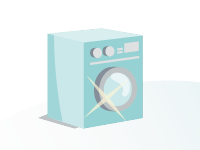
What users can save with energy and water efficient washing machinesWashing laundry is one of the most widespread tasks of housework in the world. In the past, it generally used to be hard and time-intensive mechanical work, and for many households in the world, it still is. Today, washing machines (also known as ‘clothes washers’) perform this task in many private households worldwide using water, electricity, chemical substances and process time as resources. Due to different washing habits and practices and different types of washing machines, both the consumption of resources for doing the laundry and the potential for savings vary greatly. Energy savings of 12 to 55 % and water savings of 26 to 73 % are possible with the most energy-efficient appliances available today, and even higher savings will be possible with next generation technologies. |
|
The overall worldwide saving potential from domestic washing machinesAs this is one of the basic needs, saturation of automatic clothes washing appliances is generally high in industrialised countries. At the same time, a high growth rate can be observed in developing and especially in newly industrialising countries. Today, 840 million domestic washing machines are in use worldwide, with an electricity consumption of 94 TWh per year. They cause annual greenhouse gas emissions of 62 million tons of CO2eq and also consume about 19 km3 of water. Although total energy and water consumption by washing machines is still on the increase today, energy and water efficiency could decelerate this trend and limit consumption. |
|
Technical background and design optionsDesign options exist, which would allow further reductions in specific energy and water consumption compared to the most energy-efficient appliances available today. Additional savings compared to these of up to 70 % in specific energy and water consumption can be expected, depending on appliance types. These options include horizontal-axis technology, combined with low washing temperatures and hot-fill as well as potential future design options. However, more research and development is necessary to bring appliances with such technology to the market at a reasonable price. |
|
Test procedures, measurements and standards for domestic washing machinesThe specific electricity and water consumption per washing capacity (kg) of clothes washers has already decreased during the recent years due to technical progress and energy efficiency policy schemes implemented in many world regions. These schemes also include mandatory Minimum Energy Performance Standards (MEPS) and mandatory energy labels in a growing number of countries. Much more can be achieved because the MEPS do not yet reflect the best technically and economically feasible performance. Washing machines with much better efficiency are available. Energy savings of 12 to 55 % and water savings of 26 to 73 % are possible, compared to the most popular conventional appliances. Also, the most efficient appliances worldwide are not yet available in all markets. Adequate policies based on mandatory comparative labelling schemes can help to close this efficiency gap. Policy should also support research and development. This can be done both through direct financial support for research and development as well as through demand-pull strategies, such as technology procurement and super-efficient appliance award competitions. Read more in the bigEE Policy Guide. |
|